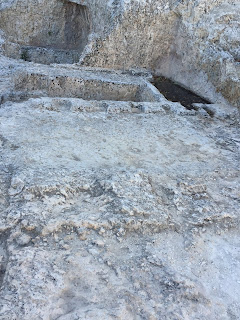KETEF HINNOM TOMBS – 2,700+ YEARS OLD
When construction began in 1980 in the western part of Jerusalem for the Menachem Begin Center, an area of special archeological interest was uncovered.
 |
| Inscription found on silver mezzuzah |
 |
| Tombs with headrests |
 |
| View from Scottish Church towards the Old City |
This narrow piece of steeply sloped land with a long-range view of the Old City of Jerusalem lay between the 19th century Scottish Church and the future Begin Center. In fact, the footprint of the new Begin Center had to be shifted about 50 feet to avoid disturbing this ancient ruin. What did trained archaeologists led by Gabriel Barkay discover as they meticulously sifted through the layers? An amazing find -- underground tombs that had not seen the light of day since the 7thcentury BCE when Jews worshipped at the First Temple during the days of King Solomon. No grave robbers had despoiled the site.
The site included a series of rock-hewn burial chambers. According to custom, the deceased were laid out next to one other with stone headrests. After one year, when the flesh had decayed, the bones were collected and placed deeper in the cave along with the bones of those who predeceased him. When speaking of Abraham’s death, Genesis 25:8 states ”Abraham breathed his last and died in a good old age, an old man and full of years, and was gathered to his people.” As scholars have concluded, this practice of reburying bones is the basis of the concept of being gathered to one’s ancestors. The Ketef Hinnom tombs show that indeed this was the burial practice in ancient Israel.
Even more extraordinary were two 2.5 cm wide silver amulets found in the fourth of the burial chambers. Each amulet contained a tiny rolled-up silver scroll that later was unrolled (after much hesitation and fear of harming the fragile silver) to a length of 10 cm. Each scroll was inscribed in proto-Hebrew script with a sharp, delicate tool with what is known in the Torah as the Priestly Benediction (Numbers 6:24-26)
May the Lord bless you and keep you;
May the Lord cause his face to shine upon you and be gracious to you
May the Lord lift up his countenance to you and grant you peace.
Since today’s photographic and computer imaging technology is much more precise than that of the 1980’s, archaeologists are able to date this writing with great precision to the late 7thcentury BCE.
These amulets preserve the earliest record of a Biblical text in an extra-Biblical document. They pre-date the Dead Sea Scrolls found in the Qumram Caves. The Ketef Hinnom amulets date back to the 7thcentury BCE before the Jews suffered their first exile from Jerusalem when Nebuchadnezzar II, king of Babylon, laid siege and destroyed the First Temple in 587 BCE.
These Ketef Hinnom amulets may be found on display today in the Israel Museum.
No comments:
Post a Comment